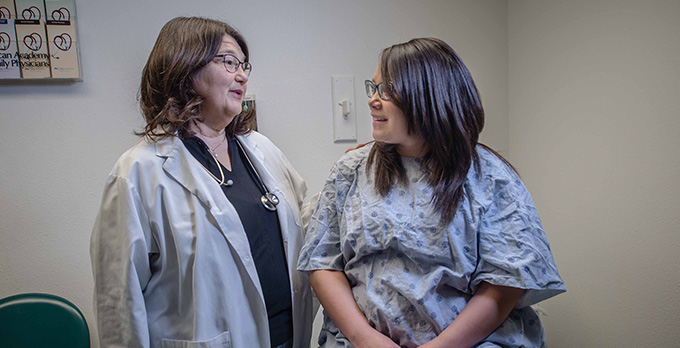Every part of a female’s reproductive system plays a significant role in fertility, pregnancy and childbirth. But many women haven’t heard words like vulva, cervix or fallopian tubes—especially if they’ve never been pregnant.
The female reproductive system has lots of parts: some you can see (the genitals) and others you can’t. It is important for your health to understand what these parts are called and how the different organs work together.
By understanding the terms your provider uses, you can ask questions or talk about your health needs more clearly. Use this guide of terms to describe your reproductive anatomy—and ask your provider if you have questions about words they use when discussing your health care.
Parts on the Outside
Vulva: The terms vulva and vagina are sometimes used interchangeably, but they are not the same. The vulva is the correct name for the outside parts of your genitals. It protects a female’s internal sexual organs. The vulva consists of the labia, clitoris, urethra, vaginal opening and Bartholin’s glands.
Labia: These flaps of skin look like lips. You have two sets of labia:
- Labia majora, the outer folds of skin that protect the other outside reproductive structures. After puberty, the skin gets covered with pubic hair.
- Labia minora, the smaller folds of skin that protect the entrances to the vagina and bladder.
Clitoris: The clitoris (female glans) sits at the top of the labia minora and extends deep within the body. It has thousands of sensitive nerves that help make sex feel good.
Urethra: This is the tiny hole from which you pee. It is located just below your clitoris and has a tube to carry urine out of the bladder.
Vaginal Opening: This hole is right below the opening to the urethra. It is where you bleed from during your period, where your partner enters you during vaginal sex and where a baby comes out during childbirth.
Bartholin’s glands: These glands are located beside the vaginal opening. They release fluid released to lubricate the vagina for sex.

Pregnancy by the Month: What to Expect
Conception through delivery, your body and the baby-to-be go through many changes.
Parts on the Inside
Uterus: This is commonly known as the womb. It is a pear-shaped, hollow organ where a baby develops during pregnancy. When you have a period, the lining of the uterus sheds and exits the body through the vagina as blood and tissue.
Ovaries: These glands are located on both sides of the uterus and hold your eggs. Ovulation occurs when one of the ovaries releases an egg. When you don’t get pregnant, the tiny egg leaves your body during your period. Ovaries also produce hormones such as estrogen, progesterone and testosterone that help your body function day to day.
Fallopian Tubes: These two narrow tubes carry eggs from the ovaries to the uterus. They also transport sperm to the egg and a fertilized egg to the uterus. Small, finger-like bits of tissue sit at the end of each fallopian tube to sweep in the egg.
Cervix: This divides the vagina and uterus, separating the vagina from the rest of the body. It lets blood out during menstruation and sperm in during sex. Its opening is no wider than a straw. The cervix dilates (stretches open) during childbirth.
Vagina: This is also known as the birth canal. It connects the cervix with the outside of the body. It can expand or contract to fit a tampon, a sex partner’s penis or a baby during childbirth.
Your body has a lot of parts. If you have questions about how it all works, please reach out. We provide confidential services tailored to any women’s health care need. We are here to help.

